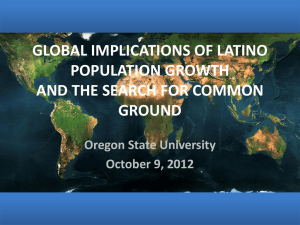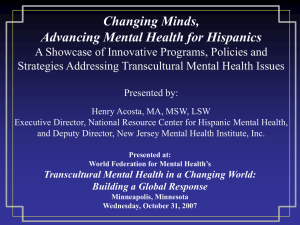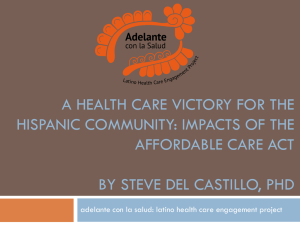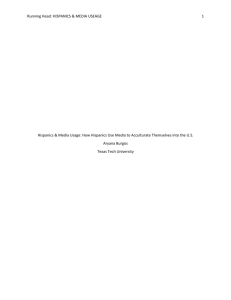The Hispanic Community of Paterson N.J.
advertisement
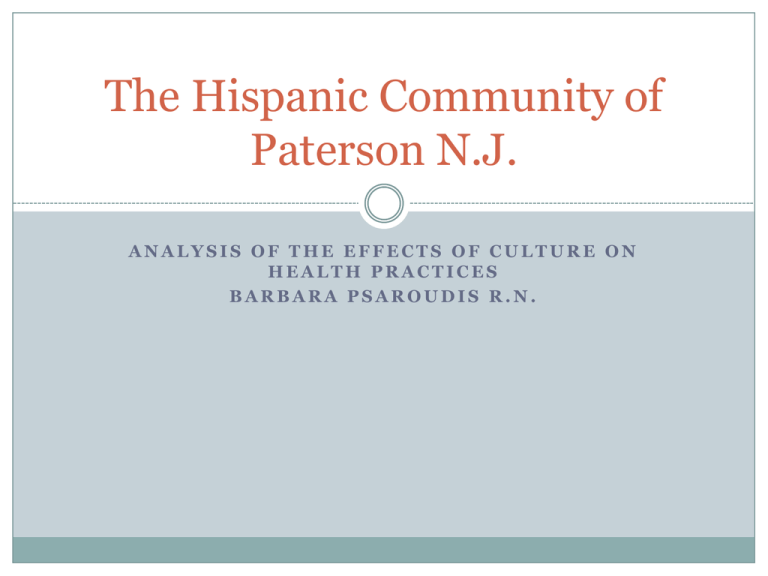
The Hispanic Community of Paterson N.J. ANALYSIS OF THE EFFECTS OF CULTURE ON HEALTH PRACTICES BARBARA PSAROUDIS R.N. Objectives of Presentation To understand the role that culture plays in health practices in the community To examine beliefs that impede or enhance health and wellness To analyze group patterns in order to facilitate positive change To propose solutions that will promote healthier lifestyles Nurses Health Care Workers Social Workers Target Audience Community Health Workers Politicians and Policy makers Hospital Administrators Physicians Clergy Outline of Presentation Description of target population Analysis of health beliefs Illness needs of community Management of health and illness needs Summary and Analysis Paterson Population Demographics 2009 Hispanic - 83,086 (56.7%) Black alone - 42,327 (28.9%) White alone - 17,858 (12.2%) Asian alone - 3,190 (2.2%) Other race alone - 1,120 (0.8%) Two or more races - 534 (0.4%) http://www.city-data.com/races/races-Paterson-New-Jersey.html Population Demographics Comparison 2000 U.S. Census **Pew Hispanic Center 2000 U.S. Census Paterson New Jersey 149,222 Hispanic– 50.1% Median household income $ 32,778 29.1% of Hispanics in Paterson live in poverty** 8,414,350 Hispanic– 13.3% Median household income-$55,146 Hispanics currently acHreHipresent over 50% of Races HH in Paterson Education tEhe Paterson EDUCATION EpElation8.2% Bachelor's degree or higher, percent of persons age 25+, 2000 –8.2% 29.8% EDUCATION High school graduates, percent of persons age 25+, 2000 - 58.5% Number % Passaic County Total Population 489,049 100 % Hispanic or Latino (of any race) 146,492 30 % Mexican 20,859 4.3% - Puerto Rican 41,324 8.4% - Cuban Other Hispanic or Latino Not Hispanic or Latino 3,009 0.6 % 81,300 16.6 % 342,557 70 % Religious Beliefs Majority are Catholic with increasing presence of Pentecostals Health is a gift from God and should not be taken for granted Prevention of illness through prayer http://culturediversity.org/hisp.htm . Social Customs Elders have prestigious status Family often looks to elders for advice Paternalism– male- dominated family Family often turns to home remedies More emotionally expressive Expectation of being pampered when ill http://culturediversity.org/hisp.htm Language 40.3% of residents of Paterson speak English at home. 50.7% of residents speak Spanish at home (49% speak English very well, 51% speak English less than very well). **Language can be a barrier is accessing Healthcare System Nutrition Latino families face disproportionately high rates of hunger, food insecurity, and obesity. Access to nutritious food is key in addressing these conditions. Need to improve nutrition in the Latino community by increasing access to federal food assistance programs, resources, and education. OBESITY One in four Hispanic adults living in the U. S. was obese (having a Body Mass Index of 30 or more). More than one in six (16.8%) Hispanic high school students is overweight. Food insecurity affects 21.7% of Latino households compared to 8.6% of non-Hispanics Hispanics' rates of being overweight are significantly higher than white high schoolers (11.8%) Greater reliance on high-calorie and high-fat foods associated with poverty and food insecurity Hispania News no date http://www.hispanianews.com/archive/2006/07/21/07.htm Obesity and Activity Diminished physical activity: Nearly half ( 47.6%) of all Hispanics live in central city households which often lack opportunities to be physically active Many poor urban families typically live in neighborhoods where getting exercise and being able to play outside is less feasible and even dangerous. Education According to a 2007 U.S. Census Bureau report, 61 percent of Hispanics in comparison to 89 percent non-Hispanic Whites have a high school diploma. 12.5 percent of Hispanics in comparison to 30.5 percent of non-Hispanic whites have a bachelor’s degree. Health Practices “Present-oriented” society leading to neglect of preventative care Birth control other than rhythm is unacceptable due to Catholicism Most see thinness as a problem and plumpness as the ideal Turn to family and friends to problem solve before Social Workers Curandero—holistic healer http://culturediversity.org/hisp.htm Health Concerns Leading causes of illness and death among Hispanics, which include heart disease, cancer, unintentional injuries (accidents), stroke, and diabetes (CDC). Other health conditions and risk factors that significantly affect Hispanics are: asthma, chronic obstructive pulmonary disease, HIV/AIDS, obesity, suicide, and liver disease. http://minorityhealth.hhs.gov/templates/browse.aspx?lvl=2&lvlID=54 Sexually Transmitted Diseases (STD) Gonorrhea prevalence rate among Hispanics/Latinos was 69.2. This rate is 1.9 times higher than the 2007 rate among whites (34.7 cases per 100,000 population). Chlamydia prevalence rate among Hispanics/Latinos (473.2) was also three times higher than that of whites (162.3) in 2007. Syphilis prevalence rate increased 22.9% among Hispanics/Latinos (from 3.5 to 4.3 per 100,000 population). (from 2006-2007) Diabetes Mexican American adults were 2 times more likely than nonHispanic white adults to have been diagnosed with diabetes by a physician. In 2005 Hispanics were 1.6 times as likely as non-Hispanic Whites to die from diabetes. End-stage renal disease (ESRD). Male Hispanics had substantially higher proportions of ESRD attributed to diabetes than did Blacks or Whites, • http://minorityhealth.hhs.gov/templates/browse.aspx?lvl=2&lvlID=54 TB Tuberculosis (TB) For the fourth consecutive year, Hispanics/Latinos exceeded all other racial or ethnic groups with the largest percentage (29%) of total cases in the United States. HIV/AIDS Hispanics/Latinos are disproportionately affected by HIV/AIDS. The overall prevalence rate for Hispanics/Latinos (585 cases per 100,000 population) was nearly three times the rate for whites (224 cases per 100,000 population). In 2005, HIV/AIDS was the fourth leading cause of death among Hispanic/Latino men and women aged 35 to 44 years. http://www.cdc.gov/nchhstp/healthdisparities/Hispanics.html Health Promotion and Disease Prevention . a. Cervical Cancer. Because of the very high incidence of cervical cancer among Hispanic/Latino women, special attention to appropriate screening is recommended. b. Diabetes. Periodic blood glucose monitoring for Puerto Rican and Mexican American elders is recommended because of the high incidence of diabetes, c. Depression. Appropriate assessment of depression is important, especially among less acculturated older women. (Espino et al, 2000) Economic Roadblocks Hispanics are more likely to be uninsured than whites or AfricanAmericans, face elevated rates of obesity, diabetes, and asthma. Community Resources Hispanic Multi-Purpose Services Center 911 East 23rd Street, Paterson, NJ 07504 (973) 684-3320 Relocation assistance, shelter, housing, emergency food, education, and employment services. Hogar Infantil 560-566 Main Street, Paterson, NJ 07503 (973) 279-4486 A child development and day care center open to all residents of Paterson, with before- and after-school programs for income-eligible families. Community Action for Social Affairs (CASA) 84-86 Mill Street, Paterson, NJ 07505 (973) 523-5452 Provides employment services, emergency food, vouchers, translation services Abstract Hispanics are currently the largest ethnic minority group in the United States and are expected to comprise approximately 30% of the total U.S. population by 2050. More generally, barring significant policy changes, immigrants and their descendants across all ethnic groups will account for most population growth during the next several decades(Pew Hispanic Center, 2008). As these trends indicate, there is an urgent need for research focused on Hispanic health Paterson N.J. is an urban city, located in northern N.J., just 25 miles from New York City. Its Hispanic residents face crime, poor education, and increasing health problems, for the most part brought on by poverty, language barriers and decreased access to primary care physicians References Demographic profile of Hispanics in New Jersey, 2008. Pew Hispanic Center. retreived from http://pewhispanic.org/states/?stateid=NJ on May 5, 2011 Espino, D.V., Palmer, R.F., Miles, T.P., Mouton, C.P., Wood, R.C., Bayne, NS, & Markides, K.P., (2000). Prevalence, incidence, and risk factors associated with hip Health disparities in HIV/AIDS, viral hepatitis, stds, and tb: Hispanics/ Latinos. Jan 25, 2010. Center for Disease Control and Prevention. retreived from http://www.cdc.gov/nchhstp/healthdisparities/Hispanics.html. May 4, 2011. Healthy foods, healthy families. NCLR National Council of La Raza. 2010 retrieved from http://www.nclr.org/index.php/issues_and_programs/health_and_nutrition/healthy_foods _families Hispanic/Latino Profile 2009. The Office of Minority Health.. Department of Health and Human Services. http://minorityhealth.hhs.gov/templates/browse.aspx?lvl=2&lvlID=54 Hispanic population health issues portend challenges for health care system KHN Kaiser Health News April 1, 2011.retreived from http://www.kaiserhealthnews.org/dailyreports/2011/april/01/hispanic-health.aspx on May 4, 2011 Key facts about childhood obesity in the Latino community. Hispania News. nd retrieved from http://www.hispanianews.com/archive/2006/07/21/07.htm on May 5, 2011. Races in Paterson, New Jersey (NJ) detailed stats: ancestries, foreign born residents, place of birth. City Data.com retrieved from http://www.city-data.com/races/races-Paterson-NewJersey.html on May 4, 2011 Resources for Spanish-speaking people. LSNJ Law. nd. retrieved from http://www.lsnjlaw.org/english/governmentaid/resources/spanishresources/ Talamantes, M., Lindeman, R. and Mouton, C. (2000). Ethnogeriatrics Curriculum Module: Health and Health Care of Hispanic/Latino American Elders.http://www.stanford.edu/group/ethnoger/ebooks/hispanic-latino_american.pdf The Hispanic American community. Transcultural Nursing retrieved from http://culturediversity.org/hisp.htm on May 5, 2011

